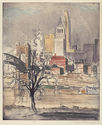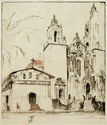
19th, 20th & 21st Century Fine Prints
707-546-7352 · fax 707-546-7924 · web: www.annexgalleries.com · email: artannex@aol.com
Max Pollak Biography
Max Pollak
American
1886–1970
Biography
Max Pollak, painter and printmaker, was born in Prague, Czechoslovakia on February 27, 1886. As an infant his family moved to Vienna, Austria where he was raised and in 1902, at age sixteen, he entered the Vienna Academy of Art. There, he studied painting and printmaking under William Unger and Ferdinand Schmutzer. In 1912 he traveled to Italy, France, and Holland to study and paint. During the First World War, he was appointed official painter of the Austrian Army and documented the stark landscapes of the places where his battalion was stationed. On December 4, 1924 he married Friederike "Friedl" Knedel, daughter of Arnold Knedel and Bertha Schweinburg, who was born in Vienna in March of 1898.
He and Friedl immigrated to the U.S. in 1927, arriving on December 16 in in New York and living for a time on the East Coast where Max traveled about and produced a series of color aquatints of New York, Cincinnati, and Detroit. His first exhibition at the 57th Street Art Gallery in New York was a commercial success and he was commissioned by Theodore Dreiser in 1929 to illustrate his book, My City, reproducing eight of Pollak's color aquatints of Manhattan. In 1938, Max and Friedl moved to San Francisco, California. Pollak was inspired by his new city and its environs and produced views of San Francisco neighborhoods, the Golden Gate Bridge, and Sausalito. Later travels included frequent trips to Mexico and Guatemala in the 1930s, '40s, and '50s.
Pollak was equally facile working in drypoint, aquatint, and soft ground etching. One of his specialties was portraiture and he produced a number of drypoints of noteworthy people and dancers throughout his career, among his most famous a 1914 portrait of Sigmund Freud at his desk surrounded by his antiquities. Freud would later become his friend and purchased several works by his fellow Austrian.
Some of Pollak's color aquatints of San Francisco and Sausalito were derived from views from his homes in those cities. His work at this time incorporated impressionistic color aquatint, experiementing with his technique so as to achieve the ever-changing atmosphere of the famous bay and its surrounding cities. In 1942 Pollak registered for the draft of men "born on or after April 28,1877 and on or before Feb. 16, 1897", listing Dr. Leon Kolb as the person who would "always know your address."
His graphic oeuvre is comprised of over 500 prints for which he won numerous awards including the Chicago Society of Etchers prize in 1942, and the California Society of Etchers awards in 1942, 1944, and 1945. Pollak exhibited at the Golden Gate International Exposition in 1939 and had numerous solo exhibitions, including a 1928 show in New York, a 1940 show at the California Palace of the Legion of Honor, and a 1973 exhibition at the Triton Museum in Santa Clara. He was a member of the Chicago Society of Etchers, the California Society of Etchers, and the Prairie Printmakers in Wichita, KS; his work is represented in the Oakland Museum of California Art; Mills College, Oakland; the Metropolitan Museum of Art; the New York Public Library; the Smithsonian American Art Museum; the de Young Memorial Museum; the Achenbach Foundation for Graphic Arts; the British Museum; and the Sigmund Freud museum.
Selected exhibitions: Urban International Exhibition of Artworks by Living Artists, Stedelijk Museum, Amsterdam, April 13-17, 1912; Annual Exhibition of Art Union for Bohemia, Rudolfinum, Prague, April-May, 1913; Exhibition of the Association of Visual Artists, Secession Building, Austria Secession, Prague, January-February, 1914; Three Etchers in California: James McNeill Whistler, Max Pollak, Kathan Brown, Oakland Museum, May, 1982 (posthumous).







